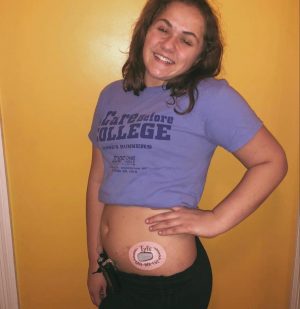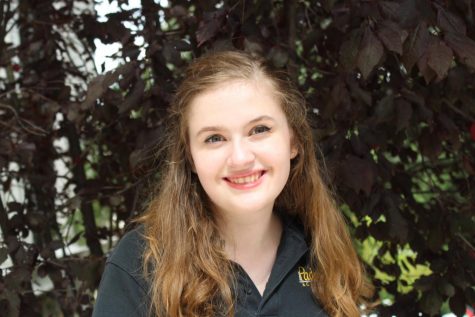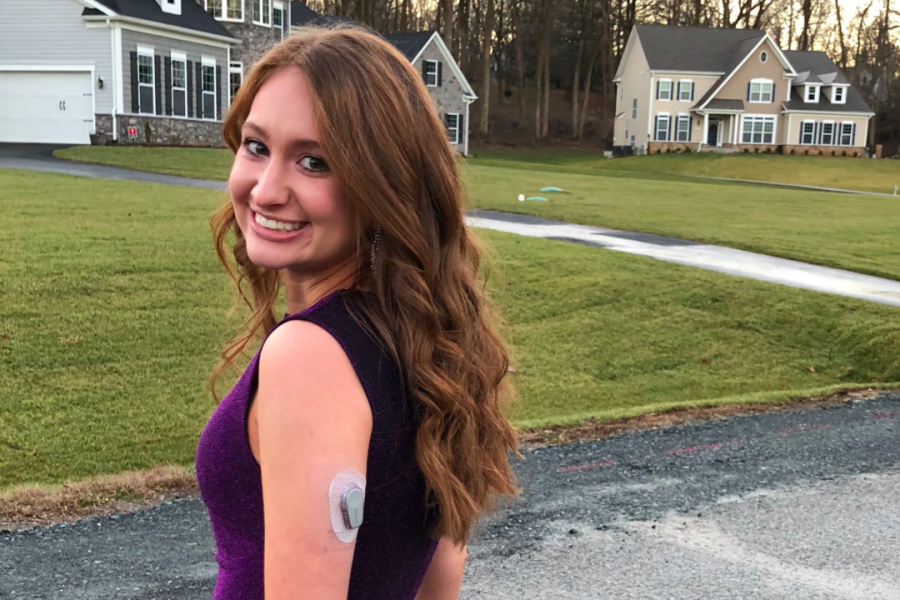Living with Type 1 Diabetes: What Diagnosed Students Want You to Know
Lauren Gempp with her Dexcom, a continuous glucose monitor. The device sends her blood sugar to her phone every five minutes.
She knew something was wrong when she began to rapidly lose weight. Around final exams in her junior year, she began drinking large amounts of water and eating excessively. Then she was no longer able to eat and felt sick constantly. And then her world changed. Lauren Gempp, a senior, was diagnosed with Type 1 diabetes.
“I had no idea, like, what a blood sugar was,” she said.
The doctors told her they would keep running some tests. Then the reality began to set in.
“I looked at my mom and I was like, I’m not giving myself a shot every time I want to eat,” she said. “I’m not doing that.”
Rose Langrehr, a senior, has lived with Type 1 diabetes for much of her life. She was eight years old when she was diagnosed, thus needing to take diabetic supplies since then.
“A vivid memory I have is my mom crying,” she said. “I was like, oh my gosh, don’t cry, it’s okay!”

Langrehr at her first Juvenile Diabetes Research Foundation (JDRF) fundraiser. JDRF works to raise funds and awareness for Type 1 diabetes research.
According to the Centers for Disease Control and Prevention, Type 1 diabetes is most commonly diagnosed before adulthood, but can strike at any age. It is a condition in which the pancreas does not produce enough or any insulin, preventing blood sugar from entering cells and producing energy.
Approximately 1.25 million Americans suffer from Type 1 diabetes, and each year about 40,000 more are diagnosed, according to the American Diabetes Association. However, only five percent of those with diabetes have Type 1—the large majority have Type 2. Type 1 diabetes, unlike Type 2, is not preventable.
Students with Type 1 diabetes report their illness to the school, and nurse Mrs. Kardos helps them manage it throughout the year.
“Every student is different,” said Mrs. Kardos. “Students at the beginning of the year typically give me a care plan that outlines what their numbers should be. Typically they come in at lunch and check their blood sugar and then may correct it.”
The SEARCH for Diabetes in Youth, which received funding from the Centers for Disease Control and Prevention and the National Institutes of Health, published a study stating that diagnoses of Type 1 diabetes increased by approximately 1.8 percent each year from 2002 to 2012, although the cause of this trend remains unsettled. Mrs. Kardos has been a nurse for 14 years, and has seen a rise in the number of young children being diagnosed with Type 1 diabetes, as well as developments in treatment, including advancements in diabetic foot care.
“In the past when they used to check their blood sugars before lunch, they would give themselves insulin for their blood sugar. Then they would go eat lunch, see what they ate, and give themselves insulin for that as well,” she said. “In order to avoid two shots at every meal, now they just check their blood sugar, estimate what they’re going to eat at lunch, and then give it all right at the same time.”

Every morning when she wakes up, Gempp checks her blood sugar. Each time she eats she must count the carbohydrates and determine how much insulin she must administer herself. Her Dexcom, a glucose monitoring tool, tells her what her blood sugar is and sends the information to her phone.
“It’s amazing, I can prevent the lows,” she said. “It’s right on my Apple Watch, too, which is awesome.”
Gempp estimates she gives herself eight short-acting shots a day and one shot of long-lasting insulin at night.
Langrehr uses an insulin pump which she changes every three days. Insulin pumps work by calculating glucose levels and providing an appropriate amount of insulin in response throughout the day by way of a catheter. She also uses the Dexcom, which she has found immensely helpful.

Langrehr poses on World Diabetes Day, Nov. 14, 2018. She was diagnosed at eight years old.
“Before I got the Dexcom I would have to check 10 to 12 times a day,” she said. “Now with the Dexcom as a continuous glucose monitor, I don’t check nearly as much. It’s really helpful.”
Langrehr still struggles with her condition. The journey to acceptance has been a long one, and it is far from over.
“It’s a thing that I have to take care of, and I take care of it,” she said. “But still, there are some days when I’m like, oh my God, why do I have to do this?”
Before she was diagnosed, Gempp said, she knew little about Type 1 diabetes and its effects. Now that it is her daily reality, she struggles to cope with a lack of knowledge amongst her peers.
“A lot of people just don’t understand, so it’s hard when you’re having a rough day because of Type 1,” Gempp said. “People are just like, ‘Just count your carbs! Just give yourself a shot!’ But this is something that you do every day for the rest of your life, it’s hard.”
“I understand that I have to take care of it,” she said. “But the emotional part of accepting it, that’s where I’m at.”
Gempp often finds herself having to educate her peers.
“Type 1 and Type 2 are very different,” she said. “Type 1 is not a lifestyle thing, there’s no prevention. There’s a lot of judgment around diabetes.”
Langrehr finds herself especially annoyed when peers make judgmental comments in passing.
“I hate when people are like, ‘Did you eat too much sugar when you were a kid?’” she said. “Or when they’re like, ‘Can you eat that?’ I can eat anything that you can eat. Should I eat a whole pizza? No. But should you?”
“I get on myself because I’m like, oh, but there are people who are worse than me, I’m overreacting, I just have to do my insulin and count my carbs and I’ll be fine,” she said. “But it’s a relevant and valid problem and I should give myself more credit.”
Dealing with her diagnosis has been a difficult journey for Gempp, but she feels that her family has been brought closer together because of it.
“My uncle has Type 1, he was diagnosed around the same age as me,” she said. “Now I look at him and I have a whole new respect for him. I think [Type 1] has strengthened the love, comfort, and support in my family.”
Gempp and Langrehr have both worked to limit the control that Type 1 diabetes has on their lives.
“Diabetes does get in the way of many things, but it almost makes it more rewarding when you do something you’re proud of on top of dealing with the daily struggles,” said Langrehr. “What I love to do most is theater. I love being on stage and producing art that has never been done before, and I love giving the audience something to laugh at or connect to. Theatre has been a passion for me for so long that I’m going to college for it.”
Langrehr will be attending Temple University in the fall, and Gempp will study at Penn State University Park.
“When I was diagnosed it was very shortly before college application time and I was so scared because I had done all this work to pick my colleges and I had my list but now I wasn’t sure if I should go as far,” Gempp said. “But I am happy to say that I am not letting Type 1 stop me from going to my number one college.”
“The Type 1 community is a super special one because everyone completely understands the daily struggle and literal highs and lows of the disease,” she said. “I hope to one day help others the way so many have helped me.”

Stella White is a senior at Padua Academy. Born in Delaware, with a wonderful British accent, Stella has spent a lot of her life growing up in England....










